

Herein lie the legacy of Brave Dunlops, Warriors all, who fought in the American War of Independence. Check the Listing for your relatives who fought in Militia's, private Companies, Artillery, Infantry, Dragoons, and the Regular Continentals.
Two Chiefs of the Dunlops fought in America against Scot and Ulster Scot
emigrant Dunlaps.
Read fascinating stories of the brave ones both in the War and afterward:
where the ground is hallowed by their blood,
and their actions upon it!
"Merito!"
Updated 2.3.09
![]()
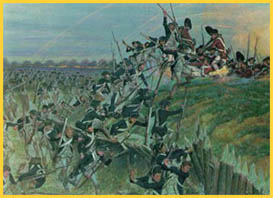
British
-General Andrew Dunlop, 20th of that Ilk. Attained Chief of Clan Dunlop in 1784. Was a Major in the King's service in the American War. He commanded a Regiment of Horse in 1795 called the Ayrshire Fencible Calvary until they were disbanded in 1800. He died in 1804 as a brigadier general in command of troops on the island of Antigua. He was the fourth son of Frances Wallace Dunlop and Sir John Dunlop. (Robert Burns and Mrs. Dunlop)
-Major General Sir James Dunlop of Dunlop, 21rst of that Ilk, fifth son of Frances Wallace. He succeeded his brother Andrew in 1804 to the Estate of and Chiefship of Dunlop. He served in the American war (82nd Regiment) where he attained the rank of Major in the King's service. He also commanded an assaulting column at the siege of Seringapatam, India. Returning to Britain, he attained the rank of Major General under Wellington during the Peninsular War of 1808-1814 (2nd Brigade: commanded by Major General Dunlop: 1st/4th Foot, 2nd/30th Foot, 2nd/44th Foot, Co Brunswick Oels) and was present at Waterloo. He completely rebuilt Dunlop House in 1835. He attained MP status for Ayr, and was created a Baronet. (Robert Burns and Mrs. Dunlop; Wallace. 1898 ; House of Dunlap, John Hanna, 1956)
-Capt. James Dunlop, Commander of the Dunlop's Company of Queen's American Rangers, a loyalist Company who fought at Germantown. Alongside Capt James fought Ensign John Dunlop. Also in the Queen's Rangers was Captain John Dunlop and Lt. Saint John Dunlop. In the Kerr's Company of the Queen's Rangers served Sgt Dunlop. In McCrea's Company served Lt. Charles Dunlop. See Dunlop's Company
Major J. Dunlop raised a Corps of Provincial Calvary in South Carolina reporting to Lord Cornwallis himself. In March of 1780 Major Dunlop was documented as being with Major Ferguson with his Corps, under direction of General Patterson, in the march from Savannah, Georgia. Major Dunlop was killed in action.
American
-John Dunlap (1746-27 Nov 1812), an Ulster Scot from Strabane, Co. Tyrone, Ulster. He was appointed printer to the Continental Congress in 1773, printing not only the first copy of the Declaration of Independence but also the Constitution of the United States. John founded the 1st Troop of Philadelphia City Calvary in 1774, seeing action in the campaign of 1776-77 at Princeton and Trenton. John also subscribed L4,000 to the American Army in 1780 . His wife was the niece to Benjamin Franklin's wife.
-Major William Dunlap, 7/3/1743-3/5/1816. William served as a Major in the Revolution throughout the entire war. He was at the surrender of General Cornwallis. The musket that he carried in the War is still in the possession of a family branch in Kentucky.
-Robert Dunlap. 1765-1846 Served as a Patriot.
 -Ensign
Robert Dunlap. 1740-1781 Lost his life for freedom at Guilford Courthouse
because he refused to obey orders to retreat! He bravely stood his ground,
firing his musket and pistols while others left all around him, until he was
alone, then overrun by the redcoats.
-Ensign
Robert Dunlap. 1740-1781 Lost his life for freedom at Guilford Courthouse
because he refused to obey orders to retreat! He bravely stood his ground,
firing his musket and pistols while others left all around him, until he was
alone, then overrun by the redcoats.
-John Dunlap 1738-1804. John was born in Philadelphia, reared in Virginia. He served as a private in Captain John Harrison's Company, Colonel Alexander Spotswood's 2nd Virginia Regiment 1777-1779. John later founded Dunlap's Station, later the city of Colerain, Ohio.
-Colonel Alexander Dunlap. 1743-3/6/1828. Founder of what is now Transylvania University in Kentucky. Alexander built Clover Lick Fort in Virginia. He served the Patriot Cause in Colonel Patterson Bell's Regiment, 5th Company, 8th Battalion, Chester City Militia, 1778.
-Adam Dunlap. 1752-1830 Settled in
Pennsylvania from Scotland. Fought in the Patriot Cause.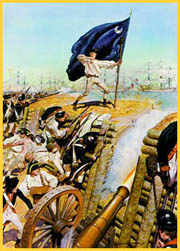
-Captain George Bryant Dunlap. 1736-1800. Served the Patriots in South Carolina. His wife lived next door to Andrew Jackson, who was to be the 7th US President.
-James Dunlop. Served as a Patriot in the famous Battle of King's Mountain, North Carolina: the turning point of the War in the South. King's Mountain Roster
- Pvt. Robert Dunlap II. 1751-1831 Born in Lancaster County, Pennsylvania. Died in Chester City, South Carolina. Served the Revolution with the famous Francis Marion, the "Swamp Fox". Also serving with the Swamp Fox were Pvt Samuel Dunlap, Pvt John Dunlop, Pvt William Dunlap and Captain Samuel Dunlap The Swamp Fox
DUNLOP, COL. JAMES, was a resident of Hopewell township, Cumberland County, as early as 1751. On the 10th of January, 1776, he was appointed major of the Sixth Battalion Pennsylvania, under Col. William Irvine, and served in the campaign of that year in Canada, and Oct. 25, 1776, was promoted lieutenant-colonel of the Tenth Pennsylvania of the Continental Line, but resigned Jan. 23, 1777, because his seniority of rank was not recognized in promotions; he was appointed Oct. 2, 1779, lieutenant of Cumberland County, and Oct. 28, 1784, commissioned justice of the Common Plea
American Prisoners of the old HMS Jersey
Prison Ship in New York Harbor
This list of names was copied from the papers of
the British War Department. There is nothing to indicate what became of any of
these prisoners, whether they died, escaped, or were exchanged. The list seems
to have been carelessly kept, and is full of obvious mistakes in spelling the
names. Yet it shall be given just as it is, except that the names are arranged
differently, for easier reference. This list of prisoners is the only one that
could be found in the British War Department. What became of the lists of
prisoners on the many other prison ships, and prisons, used by the English in
America, we do not know.
Thomas Dunlope
John Dunlope
Thomas Dunlope
Archibald Dunlopp
![]()
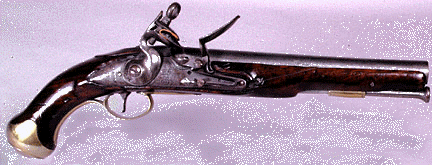
The Index to Revolutionary War Service
Records, Volume I: A-D, 1995 National Historical Publishing Company, from
the National Archives, Washington, DC. reveal the following seventy-seven other
Dunlaps , eight Delaps, one Delaep, and nine Dunlops who served the fledgling
America: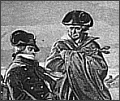
Delap, Alexander who served as a Private in
Hall's Delaware Regiment
Delap, James Service in New Hampshire: Card #6252 Roll #14
Delap, James Service in Cogwell's Regiment of Massachusetts Militia
Delap, James served as Pvt in 15th Massachusetts Regiment
Delap, James served as Pvt in the 2nd New Jersey Regiment
Delap, John served as Pvt in Philip Schuyler's Regiment of New York Militia
Delap, Thomas served in Delaware, card#6258, roll# 14
Delap, Thomas served as a Matrose in the 4th Artillery Regiment of Continental
troops
Delaep, James served as a Pvt in VanCortland's Battalion of New Jersey Militia
Dunlap,no given name served as a Captain in
the 21rst Regiment of CT Militia in 1778-81
Dunlap, Adam served as a Pvt in Finlay's Company of NH Volunteers
Dunlap, Adam served as a Corporal in Gale's New Hampshire Regiment
Dunlap, Alexander served as a Pvt in Hall's Delaware regiment
Dunlap, Alexander served as a Corporal in Hart's Battalion of Bucks County, Pa
Militia
Dunlap, Andrew served in the corps of invalids in the Continental Troops
Dunlap, Andrew served in Capt Thomas Gaddis' Company of Virginia Militia
Dunlap, Andrew served as sergeant in VanCortlandt's regiment of NY Militia
Dunlap, Andrew served in Wynkoop's NY Regiment
Dunlap, Andrew served as a cpl and sgt in the 2nd New York Regiment
Dunlap, Andrew served as a sgt in the 9th Virginia Regiment and a Pvt in the
13th Virginia
Dunlap, Archable served a Pvt in the 13th Massachusetts
Dunlap, Barius served as a Pvt in the 2nd
Regiment of Light Dragoons in the Cont Troops
Dunlap, Brice served as a Pvt in 1st Pennsylvania Battalion
Dunlap, Brice served in the 14th Pennsylvania Regiment
Dunlap, Bries served in Sheldon's Company of Connecticut Troops
Dunlap, Ephraim served as a Pvt in the Indpt
Companies of Artificers, Carpenters, and Bakers in the Cont Troops
Dunlap, Ephraim served as a Sgt in Capt Nelson's Co of Vermont Militia
Dunlap, George served as a Pvt in 26th
regiment of Cont Troops
Dunlap, George served as a Pvt in the 9th Massachusetts
Dunlap, Gidion served in Seeley's Regiment of New jersey Militia
Dunlap, Hans served as a Pvt in 3rd Regiment
of PA Troops in 1776
Dunlap, Hugh served in Baldwin's New Hampshire Regiment
Dunlap, Hugh served in New Hampshire Card# 3597 Roll# 16
Dunlap, Hugh served in Hale's regiment of New Hampshire Militia
Dunlap, J. served as a Captain in 25th
regiment of CT Militia
Dunlap, James served as a Pvt in Morgan's Rifle Regiment of Cont Troops
Dunlap, James served as a Pvt in New York Troops, Card#3601 roll#16
Dunlap, James served in NH Card#3602 Roll# 16
Dunlap, James served in Holme's Battalion of New Jersey Militia
Dunlap, James served as a Pvt in McClaughry's Regt of MY Militia
Dunlap, James served as a Cpl in the 1st New York regiment
Dunlap, James served as a Matross in the 2nd Artillery Regt Of Cont Troops
Dunlap, James served in the 2nd Regiment of New Castle Cnty Delaware Militia
Dunlap, James served as a Pvt in the 2nd New Hampshire
Dunlap, James served in the 2nd New York Regiment
Dunlap, James served in the 2nd Pennsylvania Regiment
Dunlap, James served as a Pvt in the 3rd New York Regiment
Dunlap, James served as a Pvt in the 6th
Pennsylvania Battalion, Cpt. Smith's Co.
Dunlap, James served as a private in Massachusetts
Dunlap, John served in Pa during the War,
Card#2612 roll#16
Dunlap, John served as a Lt in Campbell's Battalion of NY Militia
Dunlap, John served as a Sgt in Clyde's NY Regiment
Dunlap, John served as a Cpl in Holme's Battalion of NJ Militia
Dunlap, John served in Janson's Regiment of New York Militia
Dunlap, John served in NH during the War Card#3617 roll# 16
Dunlap, John served as a Pvt in Capt Cannon's Co of Willet's Ny Regiment
Dunlap, John served as a Pvt in Wyncoop's New York Regiment
Dunlap, John served as a Sgt in the 1st New York Regiment
Dunlap, John served as a Pvt in the 2nd Virginia Regiment,Co.4, 1777
Dunlap, Joseph served Card# 3622 roll# 16
Dunlap, Joseph served as a Pvt in Morgan's rifle Regiment of Cont Troops
Dunlap, Joseph served in Seely's Regiment of New Jersey Militia
Dunlap, Joseph served as a Pvt in the 1st and 10th Virginia
Dunlap, Joseph served as a Pvt in the 2nd Pennsylvania
Dunlap, Joseph served as a Pvt in the 9th Virginia
Dunlap, Josiah served as a Pvt in the 1st Virginia
Dunlap, Josiah served as a Pvt in the 10th Virginia Regiment
Dunlap, Josiah served in the 5th and 9th Virginia Regiment
Dunlap, Robert served as a Pvt in Patton's
Regiment of Cont troops
Dunlap, Robert served in Russell's Company of Rangers in NH Troops
Dunlap, Robert served in Seely's Regiment of NJ Militia
Dunlap, Robert served as a Pvt in the 3rd South Carolina Regiment
Dunlap, Robert served as a Pvt in the PA troops, Card# 3636 roll#16
Dunlap, Sam served as a Pvt in the 5th
Battalion of Philadelphia Cnty Militia
Dunlap, Samuel served as a Sgt in Major John Brown's Detachment of Militia in
NH, VT and MA
Dunlap, Samuel served as a Cpl in Wood's Regiment of Mass. Militia
Dunlap, Samuel served as a Pvt in Stickney's Regiment of NH Militia
Dunlap, Samuel served in Tash's 2nd New Hampshire Regiment
Dunlap, Samuel served as a Pvt in the 2nd Virginia, Co.4, 1777
Dunlap, Samuel served as a Pvt in the 4th New Jersey Regiment
Dunlap, Thomas served in Holme's Battalion of
New Jersey Militia
Dunlap, Thomas served as a Pvt in Malcom's Regiment of Cont Troops
Dunlap, Thomas served in Nichol's Regiment of New Hampshire Regiment
Dunlap, Thomas served as a Pvt in Spencer's Regiment of Cont Troops
Dunlap, Thomas served in Weissenfels'Regiment of New York Levies
Dunlap, Thomas served as a Pvt in the 3rd New York Regiment
Dunlap, Thomas served as a Matross in the 4th Artillery Regiment of Cont Troops
Dunlap, William served as a Pvt in Clyde's New
York Regiment
Dunlap, William served in Moorehead's Independent Company of PA Troops
Dunlap, William served in Levi Pawling's Regiment of New york Militia
Dunlap, William served in Sage's CT Regiment
Dunlap, William served in Van Woert's Regiment of New York Militia
Dunlap, William served in 3rd Battalion of Lancaster Cnty, Pa Militia
Dunlap, William served in South Carolina
Dunlop, Hugh; served in Baldwin's New
Hampshire Regiment
Dunlop, James; served as a Matross in 2nd artillery Regiment of Continental
troops
Dunlop, James; served as Pvt in McClaugherty's Regiment of New York Militia
Dunlop, John; served as Pvt in the 2nd Virginia Regiment
Dunlop, Nennin;served as Pvt in 2nd New Jersey , also 4th New Jersey Regiment
Dunlop, Samuel; served as Pvt in the 4th New Jersey Regiment
Dunlop, Samuel; served as Pvt in the 2nd Virginia Regiment
Dunlop, William; served in John Douglas's Regiment of CT Troops
![]()
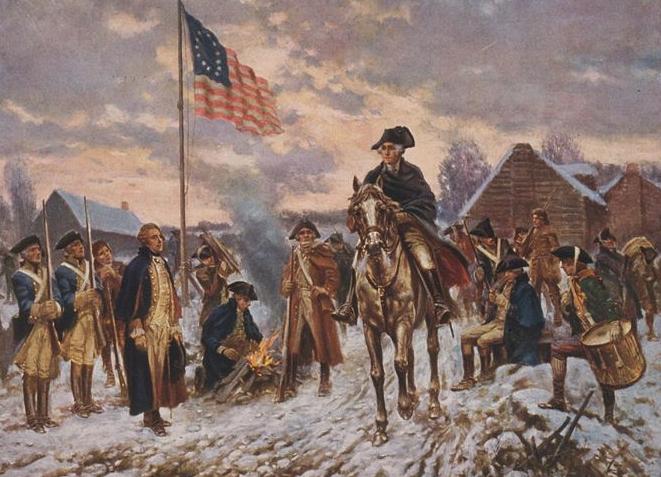
I
n 1777 British strategy included a plan to capture Philadelphia, the patriot capital.To accomplish this, the British commander in chief, Sir William Howe, landed nearly 17,000 of His Majesty’s finest troops at the head of Chesapeake Bay. To oppose them, General George Washington marched his 12,000-man army from New Jersey. People often picture the Continental Army of 1777 as a ragtag bunch of inexperienced fighters. But Washington’s men fought with skill and were often on the offensive while campaigning against superior numbers of professional soldiers.Although they lost two key battles, as well as Philadelphia, to the British, Washington’s soldiers emerged from these experiences with a renewed confidence in their fighting abilities. They only needed a little more training to reach their full potential.
As wintry weather approached, armies often withdrew to fixed camps. Transportation problems made large-scale winter operations infeasible. In choosing a site for quarters, Washington had to balance the Continental Congress’s wish for some type of winter campaign aimed at dislodging the British from the capital against the needs of his weary and poorly supplied army. By mid-December he had decided to encamp at Valley Forge.
From this location, twenty miles northwest of Philadelphia, the army was close enough to maintain pressure on the British yet far enough away to prevent a surprise attack. While the soldiers who entered camp on December 19, 1777, were not well-supplied, they were not downtrodden. This is attested to by an anonymous observer who recounted his visit to Valley Forge in the New Jersey Gazette on December 25:
“I have just returned from spending a few days with the army. I found them employed in building little huts for their winter quarters. It was natural to expect that they wished for more comfortable accommodations, after the hardships of a most severe campaign; but I could discover nothing like a sigh of discontent at their situation…On the contrary, my ears were agreeably struck every evening, in riding through the camp, with a variety of military and patriotic songs and every countenance I saw, wore the appearance of cheerfulness or satisfaction.”
Army records and eyewitness accounts speak of a skilled and capable force in charge of its own destiny. Rather than wait for deliverance, the army located supplies, built log cabins to stay in, constructed makeshift clothing and gear, and cooked subsistence meals of their own concoction. Provisions, though never abundant in the early months of the encampment, were available.
Shortages of clothing did cause severe hardship for a number of men, but many soldiers had a full uniform, and the well-equipped units patrolled, foraged, and defended the camp. The sound that would have reached your ears on approaching the camp was not that of a forlorn howling wind, but rather that of hammers, axes, saws, and shovels at work.
Under the direction of military engineers, the men built a city of 2,000-odd huts laid out in parallel lines along planned military avenues. The troops also constructed miles of trenches, five earthen forts (redoubts), and a state-of-the-art bridge over the Schuylkill River.
Disease, not cold or starvation was the true scourge of the camp. Army returns reveal that two-thirds of the nearly 2,000 men who perished died during the warmer months of March, April, and May, when supplies were more abundant. The most common killers were influenza, typhus, typhoid, and dysentery. Dedicated surgeons, capable nurses, a smallpox inoculation program, and camp sanitation regulations limited the death tolls.
Perhaps, the most important outcome of the encampment was the army’s maturation into a more professional force. The Continental Army was primed and ready to move on to the next level just as a charismatic former Prussian army officer, Baron Friedrich Wilhelm Augustus von Steuben, arrived in camp in February 1778.
Von Steuben’s hands-on training program helped the army become a more proficient marching machine. The Baron inspired a “relish for the trade of soldiering” that gave the troops a new sense of purpose and helped sustain them through many trials as they stuck to the task of securing independence.
On May 6, 1778, the army joyously celebrated France’s alliance with and formal recognition of the United States as a sovereign power. The expected arrival of the French greatly altered British war plans and triggered their evacuation of Philadelphia in June.
Washington rapidly set troops in motion to bring on a general engagement with the enemy. On June 28, at the Battle of Monmouth, N.J., Washington’s men demonstrated their improved battle prowess when they forced the British from the field.
By summer Washington could claim that the war effort was going well. Valley Forge was not the darkest hour of the Revolutionary War; it is a place where an already accomplished group of professionals stood their ground, honed their craft, and thwarted one of the major British offensives of the war. (From National Park Service http://www.nps.gov/vafo/historyculture/index.htm)
These Dunlop Clansmen were part of that history. (from the site http://www.valleyforgemusterroll.org/overview.htm )
VA25902 Dunlap Andrew VA SERGEANT 9 VA
NY22357 Dunlap Andrew NY SERGEANT 2 NY
MA32106 Dunlap George MA Private 9 Ma
MA03677 Dunlap George MA PRIVATE 9 MA
NY29877 Dunlap Jacob NY Sergeant 1 NY
NY29880 Dunlap James NY Private 1 NY
NJ10739 Dunlap John NJ PRIVATE MALCOMB
VA07273 Dunlap John VA PRIVATE 2 VA
PA23511 Dunlap Joseph PA CORPORAL 2 PA
VA07274 Dunlap Samuel VA PRIVATE 2 VA
PA30305 Dunlap Thomas PA Matrose 4 ART
NJ10642 Dunlap Thomas NJ PRIVATE MALCOMB
(Submitted by Bret Dunlap who jogs daily in Valley Forge)
